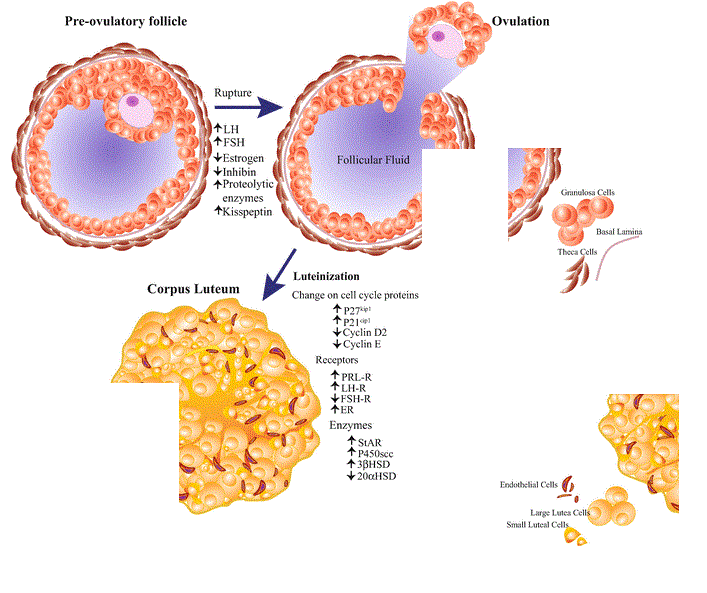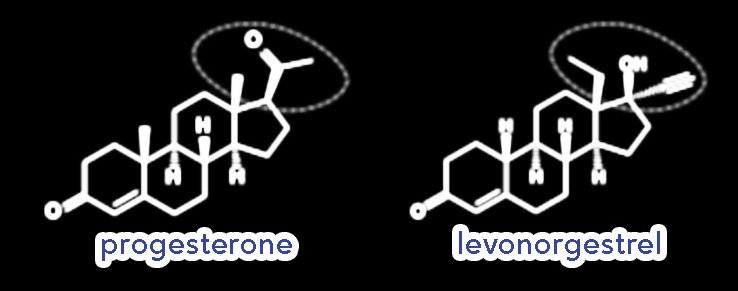Progesterone vs Progestins
Progesterone vs Progestins
You may have heard your doctor describe birth control as having "progesterone" in it, but there's more to the story.
First, let's start with progesterone. Progesterone is the body-made hormone created by the corpus luteum, a temporary endocrine organ that grows from the follicle the egg popped out of during ovulation. Now we can also supplement with oral micronized progesterone, which is synthesized from a plant source (usually yam or soy), and is bio-identical to ovarian made progesterone.
Progesterone serves an important purpose for the uterine lining. It helps hold up the endometrium for the two weeks after ovulation, and when progesterone levels finally drop (if the egg is unfertilized), this causes your next menstruation.
Progesterone also is a calming hormone with many benefits. It improves your mood and your sleep patterns, it increases your hunger slightly, it has anti-androgenic properties, and is protective for your long term cardiovascular health. It's also protective against breast cancer.
So what's in birth control? Because it's not progesterone
Progestins have several generations, meaning newer versions of the slightly altered drug are made to continue to hold patent rights for several years.
Some progestins you may see in birth control include
levonorgestrel
norethindrone
drospirenone
medroxyprogesterone
ethynodiol diacetate
norgestimate
etonogestrel
gestodene
dienogest
chlormadinone acetate
cyproterone acetate
Why are progestins in birth control? Mainly, they stop the brain from sending the message to the ovaries to begin the pre-ovulatory processes necessary to ovulate. They also reduce the quality of your cervical mucus which makes the vagina less hospitable for sperm survival.
We now know that progestins are much more effective and less dangerous than just estrogen alone, which is why *all* steroidal birth control available contains either progestins and estrogen, or just progestin on its own. This includes patches, pills, the shot, implants, and hormonal IUDs.
Progestin-only methods of birth control may stop menstruation altogether, which is called amenorrhea. Or they may cause irregular bleeding patterns and spotting, which is one of the top reasons people discontinue their use.
Progestins are chemically different, too. In contrast with progesterone, progestins have a different chemical structure from progesterone. do not metabolize the same way, and can have a range of almost opposite side effects. Progestins are synthesized as a derivative from a hormone, either from testosterone, from progesterone, or from spirolactone. They also may bind to other receptors besides progesterone, including androgen and estrogen receptors, as well as adrenal hormones like mineralocorticoids and glucocorticoids.
Can you spot the differences in chemical structure above?
The only real similarities between progesterone and progestins are that progestins can also bind to the same progesterone receptors in the body, and they both to some extent thin the uterine lining.
Side effects of the progestin use include
high blood pressure
hair loss
irregular bleeding
weight gain
androgenic
mental health issues including anxiety, depression, rage, doom, paranoia
increased risk of breast cancer
As stated above, progestins behave a little more unpredictably than home made progesterone. This means that from person to person, people react differently to taking the same progestins. Many types of hormonal birth control are combined oral contraceptives containing estrogen, which further complicates studying side effects of progestins or how they are interacting with estrogen in the pill.
One of the most frustrating parts of using progestins is the lack of informed consent around the growth of androgenic symptoms. This means that if and when the progestin you are taking decides to bind to androgen receptors this may cause acne, hirsutism, and hair loss. This can be really confusing and upsetting to people, and may take many months or years to reverse.
The confusion about progesterone vs progestins is further rooted in the fact that there is an umbrella term to encompass both progesterone and progestins called “progestogen” (sometimes spelled “progestagen”) in medical literature.
In the scientific literature there is a lot of evidencing amounting that because of these chemical differences, progestins do not behave like progesterone would on a number of different body tissues which causes an increase in serious health risks We've actually known this for a long time, because home made progesterone is necessary for pregnancy, but progestins are part of an effective way to prevent pregnancy. The major area of risk has to do with possible risk of blood clots, strokes, and heart attacks. A large study in Denmark has shown that certain types of progestins nearly double your risk of deep vein thrombosis or pulmonary embolism.
Your clot risk depends on which "generation" of progestin you use
1st gen pills - norethynodrel, norethindrone, lynestrenol and ethynodiol diacetate
2nd gen pills - levonorgestrel and norethisterone
3rd gen pills - norgestimate, desogestrel, gestodene and cyproterone acetate
4th gen pills - drospirenone, nomegestrol acetate or dienogest
Any use of progestin presents at least a 3x increased risk of cardiovascular events.
These progestins present a 6x risk (double) of life threatening deep vein thrombosis- 1st, 3rd, and 4th generation pills containing norethynodrel, norethindrone, lynestrenol and ethynodiol diacetate, norgestimate, desogestrel, gestodene and cyproterone acetate, drospirenone, nomegestrol acetate or dienogest
The safest pills came from 2nd generation - with a 3x risk of life threatening deep vein thrombosis The safest pills contain levonorgestrel and norethisterone.
Spotting potential issues while using progestins
Women generally present differently with symptoms of cardiovascular events. If you feel aching in your legs, shortness of breath, dizziness, or anything feels off, make sure you get yourself checked out if you are currently taking hormonal birth control. Most people who have an adverse event did have warning signs, but didn't know how serious they might be.
In addition, there is evidence to suggest that progestins increase your risk of breast cancer during your menstruating years. The studies were also conducted on menopausal women to see if using progesterone instead of progestins with estrogen decreased risk of breast cancer. They found that it did have a statistically significant difference.
There's been a serious under-estimation of the importance of progesterone in menstrual and overall health. We hope to change that through body literacy.
And even in menstrual health, we misrepresent progesterone significantly.
The top graphic: Menstrual Cycle pattern with estrogen and progesterone as seen in the textbook
The bottom graphic: If we actually measured the serum amount of estrogen versus progesterone
What does this tell us? We make a LOT of progesterone each menstrual cycle!! If we thought estrogen was important, look just how important progesterone is to our overall health by just how much of it we make. And the core point here is that our body has a natural way of making all the progesterone we need.
Through Ovulation!
Can you see the corpus luteum, or "yellow body" on this ovary below? It's bigger than you thought right? Our body makes this! It's absolutely amazing!




